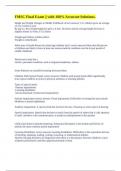FMSC Final Exam || with 100% Accurate Solutions.
Height and Weight Changes in Middle Childhood correct answers U.S. children grow an average
of 2 to 3 inches a year
By age 11, the average height for girls is 4 feet, 10 inches and the average height for boys is
slightly shorter at 4 feet, 9 1/2 inches
Weight gain follows similar pattern
Weight is redistributed
What sorts of health threats do school-age children face? correct answers More than 90 percent
of children are likely to have at least one serious medical condition over the 6-year period of
middle childhood.
About one in nine has a
chronic, persistent condition, such as migraine headaches, asthma
Some illnesses are actually becoming more prevalent.
Children With Special Needs correct answers Children with special needs differ significantly
from typical children in terms of physical attributes or learning abilities.
Types of special needs:
-Sensory impairments
-Learning disabilities
-Social-emotional or behavioral impairments
Sensory Impairment correct answers Visual impairment: Difficulties in seeing that may include
blindness or partial sightedness
Auditory impairment: A special need that involves the loss of hearing or some aspect of hearing
Speech impairment: Speech that deviates so much from the speech of others that it calls attention
to itself, interferes with communication, or produces maladjustment in the speaker
Child-onset fluency disorder/stuttering: Substantial disruption in the rhythm and fluency of
speech; the most common speech impairment
Learning Disabilities correct answers Learning disabilities: Difficulties in the acquisition and use
of listening, speaking, reading, writing, reasoning, or mathematical abilities
Specific learning disorders are diagnosed when there is a discrepancy between children's actual
academic performance and their apparent potential to learn.
,-Dyslexia
-Executive functioning
-Auditory processing
Mainstreaming and Full Inclusion correct answers Congress passed Public Law 94-142, the
Education for All Handicapped Children Act, in the mid-1970s.
-Least restrictive environment
-Mainstreaming
-Full inclusion
Autism Spectrum Disorders correct answers -Apparent by age 3
-Pervasive developmental delay
-1 in 88 American children are on the autism spectrum
-1 out of 54 boys; 1 out of 252 girls
-Core features: Preserve sameness in environment, social isolation, severe language deficits
Attention Deficit/Hyperactivity Disorder correct answers ADHD/ADD looks differently in
different kids
-Impulsivity, easily distracted, hard time concentrating, motivational difficulty, restless, fidgety
-Higher incidence in boys
-Potential causes
Anxiety Disorders correct answers -Internalizing disorder
-Generalized anxiety disorder
-Separation anxiety disorder
-Obsessive compulsive disorder
-Post traumatic stress disorder
-Causes
Depression correct answers -Internalizing disorder
-2% of children, 8% of adolescents qualify for a diagnosis
-Somatic symptoms
-Irritable mood, socially withdrawn
-Associated with a history of psychosocial adversity (stress, anxious attachment, physical or
sexual abuse)
-Suicide
Disruptive Behavior Disorders correct answers Oppositional Defiant Disorder
Negative, hostile, defiant behavior
Conduct Disorder
Pattern of behavior that violates rights of others or major age-appropriate social norms
Early onset
Early examples of physical aggressiveness, restlessness, subtle deficits in cognitive functioning
Rejection by peers, high conflict, limited social skills
, Harsh parenting or parental rejection, abuse, avoidant attachment
Late onset (puberty)
Peer context
Better prognosis
Oppositional Defiant Disorder correct answers Negative, hostile, defiant behavior
Conduct Disorder correct answers Pattern of behavior that violates rights of others or major age-
appropriate social norms
Early onset
Early examples of physical aggressiveness, restlessness, subtle deficits in cognitive functioning
Rejection by peers, high conflict, limited social skills
Harsh parenting or parental rejection, abuse, avoidant attachment
Late onset (puberty)
Peer context
Better prognosis
Other Childhood Disorders correct answers -Tic Disorders (Tourette's)
-Enuresis and Encopresis
-Pica
-Language disorders
-Learning disorders
-Selective Mutism
-Separation Anxiety
-Reactive Attachment Disorder
Intelligence correct answers Various types of intelligence
-Academic intelligence (IQ)
-Practical intelligence ("street smarts")
-Emotional intelligence (EQ)
Intelligence Theories
Gardner's Theory of Multiple Intelligences correct answers Linguistic: understanding/using
language
Rhythmic/Musical: skill in creation of music
Logical-Mathematical: logical thinking and reasoning about quantities




